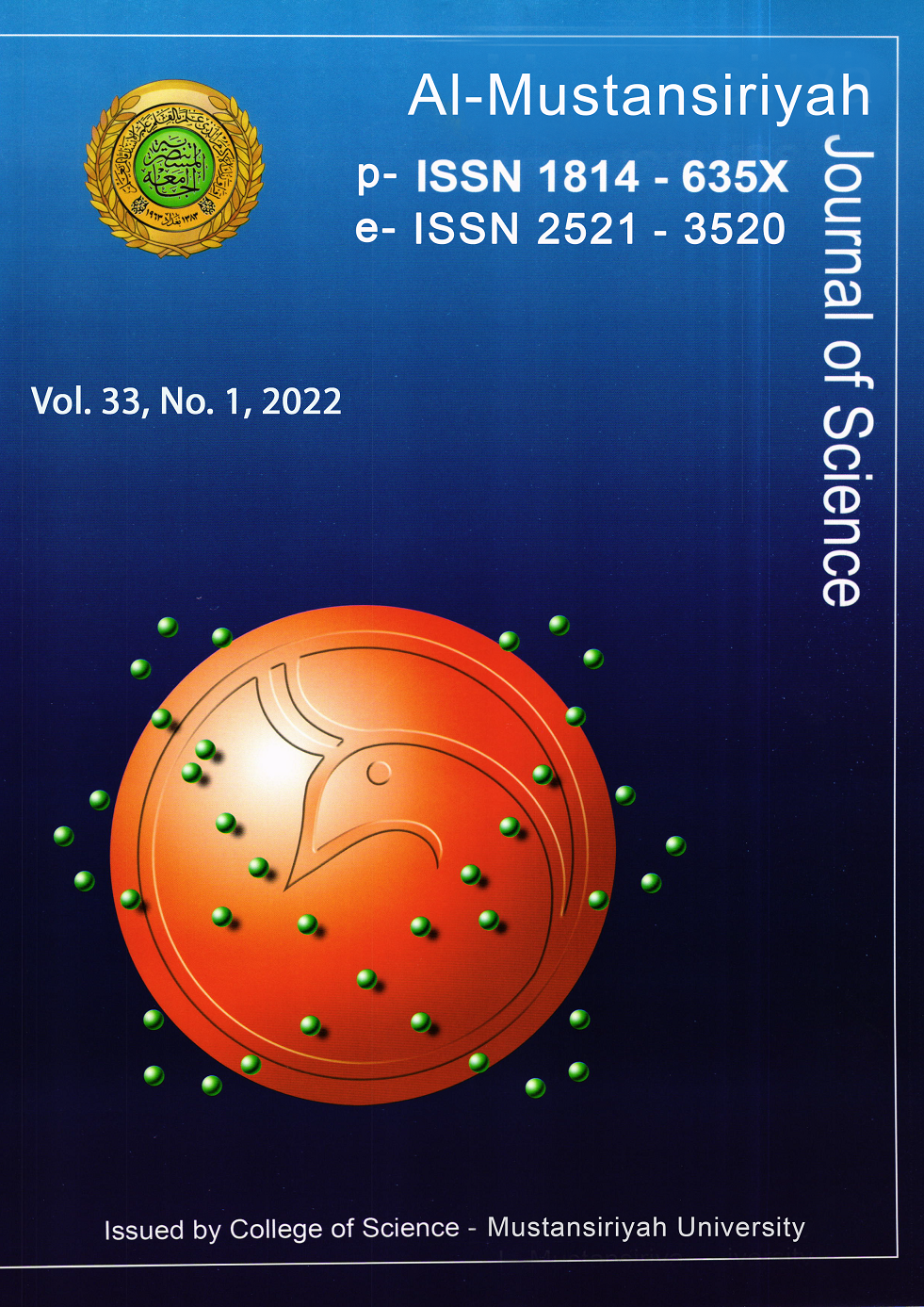Effect of cultivation conditions on hemolysin production from clinical isolates of Serratia marcescens
DOI:
https://doi.org/10.23851/mjs.v33i1.1080Keywords:
Serratia marcescens, hemolysin, cultivation conditionAbstract
Sixty-four isolates were collected from clinical sources in Baghdad and Mosul city. The identification of S. marcescens confirmed by using API 20E and VITEK-2 systems. Twelve isolates of S. marcescens produced hemolysin, which were detected by two ways, qualitative hemolytic assay and quantitative hemolytic assay. The optical density of hemolysin producing isolates at standard condition (37oC, pH=7, 24h) showed that Serratia marcescens (SmU9) isolate gave the highest absorbance of hemolysin production (0.7) but at (25°C, pH=7,24h) the absorbance of hemolysin production turn into (3.0), compared with the absorbance at 571nm for Control without hemolysin (0.060) and completely hemolysis by Triton x-100 (6.0). However, the optimum optical density of the best hemolysin producing isolate (SmU9) at the optimum cultivation conditions (25°C, pH=9, 24h, 150 rpm, 1% inoculum size in Nutrient broth) was (6.0).
Downloads
References
Bayona; S. J. B.; Chua L.; Lynn, Y. T. and Randall, I. F. (2009). Unknown Bacteria Identification: The Serratia marcescens Project. Department of Biology Microbiology Laboratory Class, University of Philippines Manila.
Zhang, Q. (2004). Genetic analysis of Serratia marcescens, the causal agent of cucurbit yellow vine disease (Doctoral dissertation, Oklahoma State University).
Soenens, A., & Imperial, J. (2020). Biocontrol capabilities of the genus Serratia. Phytochemistry Reviews, 19(3), 577-587.
Kefford, B., Kjelleberg, S., & Marshall, K. C. (1982). Bacterial scavenging: utilization of fatty acids localized at a solid-liquid interface. Archives of Microbiology, 133(4), 257-260.
Mazar, J., & Cotter, P. A. (2007). New insight into the molecular mechanisms of two-partner secretion. Trends in microbiology, 15(11), 508-515.
Hertle, R., Brutsche, S., Groeger, W., Hobbie, S., Koch, W., Könninger, U., & Braun, V. (1997). Specific phosphatidylethanolamine dependence of Serratia marcescens cytotoxin activity. Molecular microbiology, 26(5), 853-865.
Letoffe, S., Ghigo, J. M., & Wandersman, C. (1994).Iron acquisition from heme and hemoglobin by a Serratia marcescens extracellular protein. Proceedings of the National Academy of Sciences, 91(21), 9876-9880.
Shimuta, K., Ohnishi, M., Iyoda, S., Gotoh, N., Koizumi, N., & Watanabe, H. (2009). The hemolytic and cytolytic activities of Serratia marcescens phospholipase A (PhlA) depend on lysophospholipid production by PhlA. BMC Microbiology, 9(1), 1-10.
Di Venanzio, G., Stepanenko, T. M., & García Véscovi, E. (2014). Serratia marcescens ShlA pore-forming toxin is responsible for early induction of autophagy in host cells and is transcriptionally regulated by RcsB. Infection and Immunity, 82(9), 3542-3554.
Hertle, R., Hilger, M., Weingardt‐Kocher ,S., & Walev, I. (1999).Cytotoxic action of serratia marcescens hemolysin on human epithelial cells. Infection and Immunity, 67(2), 817-825.
Gulbahar F. Karim. (2019). Prevalence of Serratia Species Isolated from Children with Diarrhea and Studying their Virulence Factors. Indian Journal of Public Health Research & Development, 10(6), 1111-1116.
Marre R., Hacker J., Braun V. (1989). The cell-bound hemolysin of Serratia marcescens contributes to uropathogenicity. Microbial Pathogenesis, 7(2), 153-156.
Gonzalez-Juarbe, N.; Mares, C.A.; Hinojosa, C.A.; Medina, J.L.; Cantwell, A.; Dube, P.H.and et al.(2015). Requirement for Serratia marcescens cytolysin in a murine model of hemorrhagic pneumonia. Infection and Immunity, 83(2):614- 624.
Maarib N. Rasheed, Siham Hamel Mohaisen, Khairiyah Jaber AL- Khtaua. (2020). Isolation,Molecular Identification and Influence of Incubation Period on Hemolysine Gene Expression in Serratia marcescens Local Isolates. International Journal of Natural and Engineering Sciences. 14 (1): 3-7.
Alonso Fernandez, R., & Baquero Mochales, F. (1994). Genus Serratia: biology,clinical repercussions and epidemiology. Revista Clinica Espanola, 194(4), 294-299.
Subashkumar, R., & Gayathri, N. (2017). Phenotypic and Genotypic Characterization of Serratia marcescens from Clinical and Environmental Sources. International Journal Of Pharmacognosy And Phytochemical Research, 9(11), 1392-1397.
Poole, K. E. I. T. H., & Braun, V. O. L. K. M. A. R. (1988). Influence of growth temperature and lipopolysaccharide on hemolytic activity of Serratia marcescens. Journal of Bacteriology, 170(11), 5146-5152.
Rasheed, M. N., & Mohaisen, S. H. (2017). Study of some environmental factors role in hemolysin gene expression in serratia marcescens local isolates. Pak. J. Biotechnol. Vol, 14(4), 753-759.
Frankena, J., Koningstein, G. M., van Verseveld, H. W., & Stouthamer, A. H. (1986). Effect of different limitations in chemostat cultures on growth and production of exocellular protease by Bacillus licheniformis. Applied Microbiology and Biotechnology, 24(2), 106-112.
Carbonell, G. V., Fonseca, B. A. L., Figueiredo, L. T. M., Darini, A. L. C., & Yanaguita, R. M. (1996). Culture conditions affect cytotoxin production by Serratia marcescens. FEMS Immunology & Medical Microbiology, 16(3-4), 299-307.
Hilger, M.,& Braun, V. (1995). Superlytic hemolysin mutants of Serratia marcescens. Journal of Bacteriology, 177(24), 7202-7209.
Franzon, J. H., & Santos, D. S. (2004). A role for histone-like protein H1(H-NS) in the regulation of hemolysin expression by Serratia marcescens. Brazilian journal of medical and biological research, 37(12), 1763-1769.
Di Venanzio,G.; Lazzaro,M.; Morales, E. ; Krapf, D.and Véscovi ,E.(2017). A pore‐forming toxin enables Serratia a nonlytic egress from host cells. Cellular Microbiology, 19 (2):1-12.
Miao, Y., Li, G., Zhang, X., Xu, H., & Abraham, S. N. (2015). A TRP channel senses lysosome neutralization by pathogens to trigger their expulsion. Cell, 161(6), 1306-1319.
Abel, E. ; Ibrahim, N. and Huyop, F. (2012). Identification of Serratia marcescens SE1 and determination of its herbicide 2,2-dichloropropionate (2,2-DCP) degradation potential. Malaysian Journal of Microbiology, Vol. 8(4), pp. 259-265.
Moon, S. H., & Parulekar, S. J. (1991). A parametric study ot protease production in batch and fed‐batch cultures of Bacillus firmus. Biotechnology and bioengineering, 37(5), 467-483.
Qu, Y., Zhang, R., Ma, F., Zhou, J., & Yan, B. (2011). Bioaugmentation with a novel alkali-tolerant Pseudomonas strain for alkaline phenol wastewater treatment in sequencing batch reactor. World Journal of Microbiology and Biotechnology, 27(8), 1919-1926.
Yang, Z., & Wu, F. (2006). Catalytic properties of tyrosinase from potato and edible fungi. Biotechnology, 5(3), 344-348.
Turner, B. L. (2010). Variation in pH optima of hydrolytic enzyme activities in tropical rain forest soils. Applied and Environmental Microbiology, 76(19), 6485-6493.
Rodrigues, R. C., Ortiz, C., Berenguer-Murcia, Á., Torres, R., & Fernández-Lafuente,R.(2013). Modifying enzyme activity and selectivity by immobilization. Chemical Society Reviews, 42(15), 6290-6307.
Qiu, J., Han, H., Sun, B., Chen, L., Yu, C., Peng, R., & Yao, Q. (2016). Residue mutations of xylanase in Aspergillus kawachii alter its optimum pH. Microbiological research, 182, 1-7.
Clarke, S. C., Haigh, R. D., Freestone, P. P. E., & Williams, P. H. (2003). Virulence of enteropathogenic Escherichia coli, a global pathogen. Clinical microbiology reviews, 16(3), 365.
Kenny, B., Abe, A., Stein, M., & Finlay, B. B. (1997). Enteropathogenic Escherichia coli protein secretion is induced in response to conditions similar to those in the gastrointestinal tract. Infection and immunity, 65(7), 2606.
Mabrouk, S. S., Hashem, A. M., El-Shayeb, N. M. A., Ismail, A. M., & Abdel-Fattah,A. F. (1999).Optimization of alkaline protease productivity by Bacillus licheniformis ATCC 21415. Bioresource Technology, 69(2), 155-159.
Abd Rahman, R. N. Z., Geok, L. P., Basri, M., & Salleh, A. B. (2005). Physical factors affecting the production of organic solvent-tolerant protease by Pseudomonas aeruginosa strain K.Bioresource technology, 96(4), 429-436.
Shafee, N., Aris, S. N., Rahman, R. N. Z. A., Basri, M.,& Salleh, A. B. (2005). Optimization of environmental and nutritional conditions for the production of alkaline protease by a newly isolated bacterium Bacillus cereus strain 146. J Appl Sci Res, 1(1), 1-8.
Bidlas, E., Du, T., & Lambert, R. J. (2008). An explanation for the effect of inoculum size on MIC and the growth/no growth interface. International journal of food microbiology, 126(1-2), 140-152.
Davis, K. E., Joseph, S. J., & Janssen, P. H. (2005). Effects of growth medium, inoculum size, and incubation time on culturability and isolation of soil bacteria. Applied and environmental microbiology, 71(2), 826.
Teng, Y., & Xu, Y. (2008). Culture condition improvement for whole-cell lipase production in submerged fermentation by Rhizopus chinensis using statistical method. Bioresource technology, 99(9), 3900-3907.
Sen, R., & Swaminathan, T. (2004). Response surface modeling and optimization to elucidate and analyze the effects of inoculum age and size on surfactin production. Biochemical Engineering Journal, 21(2), 141-148.
Kammoun, R., Naili, B., & Bejar, S. (2008).Application of a statistical design to the optimization of parameters and culture medium for alpha-amylase production by Aspergillus oryza CBS 819. Bioresour Technol, 99(13).
Rajeswari, M., & Bhuvaneswari, V. (2016). Production of extracellular laccase from the newly isolated Bacillus sp. PK4. African Journal of Biotechnology, 15(34), 1813-1826.
Lysyk, T. J., Kalischuk-Tymensen, L. D., & Selinger, L. B. (2002). Comparsion of selected growth media for culturing Serratia marcescens, Aeromonas sp., and Pseudomonas aeruginosa as pathogens of adult Stomoxys calcitrans (Diptera: Muscidae). Journal of Medical Entomology, 39(1), 89-98.
Lee, K. K., Yii, K. C., Yang, T. I., Hong, H. I., & Liu, P. C. (1999). Protease and virulence of the extracellular products produced by Vibrio carchariae after growth on various media. Zeitschrift für Naturforschung C, 54(5-6), 383-386.
Palaniyappan, M., Vijayagopal, V., Viswanathan, R., & Viruthagiri, T. (2009). Screening of natural substrates and optimization of operating variables on the production of pectinase by submerged fermentation using Aspergillus niger MTCC 281. African journal of Biotechnology, 8(4).
Negi, S., & Banerjee, R. (2010). Optimization of culture parameters to enhance production of amylase and protease from Aspergillus awamori in a single fermentation. African Journal of Biochemistry Research, 4(3), 73-80.
Slonczewski, L. J., Foster, W. J., & Gillen, M. K. (2009). Microbiology An Evolving Science‖ WW Norton Company. Inc., New York.
Wang, J. J., & Shih, J. C. H. (1999). Fermentation production of keratinase from Bacillus licheniformis PWD-1 and a recombinant B. subtilis FDB-29. Journal of Industrial Microbiology and Biotechnology, 22(6), 608-616.
Somerville, G. A., & Proctor, R. A. (2009). At the crossroads of bacterial metabolism and virulence factor synthesis in Staphylococc. Microbiology and molecular biology reviews:MMBR, 73(2),233.
Nascimento, W. C. A. D., & Martins, M. L. L.(2004). Produção e propriedades de uma protease extracelular de um Bacillus sp termofílico. Brazilian Journal of Microbiology, 35(1-2), 91-96.
Abusham, R. A., Rahman, R. N. Z. R., Salleh, A. B., & Basri, M. (2009). Optimization of physical factors affecting the production of thermo-stable organic solvent-tolerant protease from a newly isolated halo tolerant Bacillus subtilis strain Rand. Microbial Cell Factories, 8(1),1-9.
Somerville, G. A., & Proctor, R. A. (2013). Cultivation conditions and the diffusion of oxygen into culture media: the rationale for the flask-to-medium ratio in microbiology. BMC Microbiology, 13(1), 1-2.
Mantzouridou, F., Roukas, T., & Kotzekidou, P. (2002). Effect of the aeration rate and agitation speed on β-carotene production and morphology of Blakeslea trispora in a stirred tank reactor: mathematical modeling. Biochemical Engineering Journal, 10(2), 123-135.
Kim, S. W., Hwang, H. J., Xu, C. P., Choi, J. W., & Yun, J. W. (2003). Effect of aeration and agitation on the production of mycelial biomass and exopolysaccharides in an enthomopathogenic fungus Paecilomyce sinclairii. Letters in Applied Microbiology, 36(5), 321-326.
CrossRef |
">PubMed
Downloads
Key Dates
Published
Issue
Section
License
Copyright (c) 2022 Al-Mustansiriyah Journal of Science

This work is licensed under a Creative Commons Attribution-NonCommercial 4.0 International License.
(Starting May 5, 2024) Authors retain copyright and grant the journal right of first publication with the work simultaneously licensed under a Creative Commons Attribution (CC-BY) 4.0 License that allows others to share the work with an acknowledgement of the work’s authorship and initial publication in this journal.






















